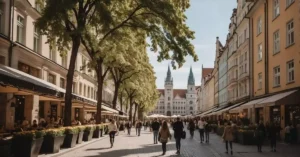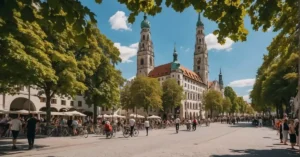The Munich Flag stands as a highly recognizable and significant emblem throughout Bavaria, and arguably across Germany as well. We’re going to delve into the history and significance of this flag. From what we’ve gathered, here are the key details you should know. Let’s dive in.
History of the Munich Flag
You might have seen Munich’s iconic flag and wondered about its origins. It’s a flag steeped in history, reflecting Munich’s rich past as part of the Bavarian Statehood. This black and yellow standard has been a symbol of the city since the Middle Ages, connecting you to Munich’s longstanding heritage.
Features of the Munich Flag

- Date of Introduction: The Munich City Seal featuring the heraldic monk figure dates back to 1304.
- Colors: The flag consists of two horizontal stripes, black and yellow. These colors are believed to be connected to the Holy Roman Empire, under which Munich fell during its early history.
Chronological Highlight
| Century | Event |
|---|---|
| 8th | Munich was originally a Benedictine settlement near the monks’ monastery. |
| 12th | Munich becomes more prominent, receiving city status in 1175 during the Duchy of Bavaria. |
| 14th | The Munich flag starts to become more pervasive in the city’s iconography. |
| 19th | Under the Kingdom of Bavaria, Munich continues to flourish and its flag becomes a symbol of this era. |
| 20th | Post-Bavarian Soviet Republic, the flag remains an emblem within the Federal Republic of Germany. |
As the capital of Bavaria, Munich’s flag is closely tied to the Bavarian flag and has evolved alongside it. The design has remained relatively consistent, reflecting Munich’s stability and the importance of tradition. The Munich flag symbolizes your connection to a city that has witnessed the Wittelsbach Dukes’ reign and weathered the transformations of German statehood, from a Duchy to its current position in modern-day Germany.
Design and Symbolism

When you look at the Munich Flag, you’re not just seeing colors and patterns; you’re witnessing a tapestry of history and identity. This black and gold standard is more than just a flag; it carries the heart of Munich on its fabric.
| Color | Meaning |
|---|---|
| Black | Represents determination and often the color of the monk’s robe in the city’s coat of arms |
| Gold | Symbolizes excellence and a rich history |
| Blue | Reflects the Bavarian heritage |
The Coat of Arms at the center is a vital part of this flag, featuring a Münchner Kindl, or Munich child, which is styled as a monk. This figure is a historical nod to the city’s name origin—München, derived from the old German word ‘Munichen,’ meaning ‘by the monks.’
The Bavarian Flag is often seen alongside Munich’s own, notable for its iconic blue and white colors, representing the scenic skies and snowy Alps. Its design, known as the “Rautenflagge,” or lozengy pattern, symbolizes the noble Wittelsbach family, who ruled Bavaria for centuries. When these flags flutter side by side, they illustrate a union of municipal pride and regional loyalty.

| Symbols | Representation |
|---|---|
| Monk | The city’s monastic roots |
| Lozengy | The Bavarian dynasty and the connection to the state |
| Arms | The historical significance of Munich |
Each time you see the flag’s colors streaming in the wind or the Coat of Arms standing proud, you’re looking at a celebration of Munich’s past, its present, and its aspirations for the future.
Heraldic Rules and Proportions
You’ve probably noticed that flags carry a sense of dignity and tradition, and none more so than those with a heraldic design. The Munich flag is a prime example of how heraldic rules guide the aesthetic and symbolism of a region’s identity. In Munich’s case, these rules dictate that bicolor patterns and precise proportions enhance the flag’s symbolism and visibility.
When you look at a banner or a flag, its proportions are essential. They’re the ratio between the flag’s width (often horizontal) and its length (or vertical). Typically, these ratios range from 1:1 (square) to 1:2 (twice as long as it is high).
Here’s a simple breakdown of proportions seen in vertical flags and banners:
| Flag Type | Width | Height | Common Ratio |
|---|---|---|---|
| Stylized Heraldic Banner | 1 | 1 | 1:1 |
| Standard Flag | 1 | 1.5 | 1:1.5 |
| Long Vertical Flag | 1 | 2 | 1:2 |
As per the heraldic rules, Munich’s flag often reflects the local ruling family’s coat of arms in its design, which, for Munich, is the powerful Wittelsbach dynasty. By using these elements, the flag highlights both historical reverence and regional pride. In Munich, vertical flags may bear the city’s colors arranged vertically, with each color holding equal width and the entire flag conforming to established ratios of width to length for maximum legibility and respect to tradition.
Munich Flag Variants
You might be familiar with the striking black and gold colors of the Munich flag, but did you know there are different versions that all hold special meaning within the city and the wider state of Bavaria? These variations are flown proudly, from the Town Hall to the streets of the city’s districts.

Standard Variants:
- Variant 1: Features two horizontal stripes—black over yellow.
- Variant 2: Has black and yellow lozenges, similar to the Bavarian flag.
Municipal and Special Flags:
- Town Hall Exclusive: A special flag reserved for the Town Hall, sometimes adorned with the Münchner Kindl.
- Municipal Districts: Different districts may have their own derivatives, though not as common.
Comparing to the State Flag: In contrast to Munich’s city flag, the Bavarian State Flag might feature similar colors but incorporates distinct patterns and symbols.
Historical and County Flags: Neighboring areas like Dachau, Freising, and Regensburg can have their own flags, which reflect their local heritage and coat of arms.

| Flag Variant | Primary Colors | Special Features |
|---|---|---|
| Standard Variant 1 | Black, Yellow | Two horizontal stripes |
| Standard Variant 2 | Black, Yellow | Lozenge pattern |
| Town Hall Exclusive | Black, Yellow | Münchner Kindl (Munich Child emblem) |
| Bavarian State Flag | Variable | More elaborate patterns/symbols |
This brief overview helps you appreciate the heritage that each variant of the Munich flag represents, reflecting the pride of Munich and the distinct identity within its districts and neighboring counties.
Cultural Significance

The Munich flag, with its striking black and gold colors, nods to centuries of history that you can feel throughout the city. As you wander Munich’s streets, you’re enveloped in tradition, where modernity intersects with customs that have long defined this vibrant city.
Let’s take a look at how the flag weaves into the rich tapestry of Munich’s culture:
- Oktoberfest: This world-famous festival celebrates Bavarian culture, and the Munich flag can be seen flying high amidst the beer tents, symbolizing local pride and heritage.
- Beer: Integral to Munich culture, the flag often decorates breweries, Beer gardens and beer halls, linking the city’s renowned brewing tradition to its identity.
- FC Bayern Munich: The flag’s colors are sported with pride by passionate supporters of the city’s beloved football team, uniting fans in a display of solidarity.
- Landeshauptstadt München: As the capital city of Bavaria, Munich’s flag represents the heart and soul of regional governance at places like the Neues Rathaus.
| Key Locations in Munich | Relationship to Flag |
|---|---|
| Neues Rathaus | Flies the flag, representing municipal pride |
| Frauenkirche | Often backdrop for flag-related ceremonies |
| Feldherrnhalle | Historical site displaying the flag |
| Marienplatz | Central square where the flag is prominent |
In Munich, every corner turned and every festival attended reaffirms the flag’s enduring legacy. You’ll see it celebrated during city-wide events, solemnly hoisted on government buildings, and merrily waved at football matches. It’s more than just a symbol; it’s a unifier that encapsulates the joy, resilience, and pride of Munich.
Usage and Display

When you wander through Munich, the presence of the Munich flag is distinct across public buildings and landmarks. With its black and gold colors, it’s a symbol that represents the pride and heritage of Landeshauptstadt München, the capital and most populous city of Bavaria.
Public Buildings: Most governmental and municipal buildings across Munich proudly display the flag. This includes the iconic Neues Rathaus (New Town Hall), where the flag is often spotted fluttering in the breeze.
Government Use: The flag is utilized in official capacities by the government of Munich. During state events and holidays, it’s not uncommon to see a sea of black and gold alongside the blue and white of the Bavarian flag.
| Location | Flag Display |
|---|---|
| Neues Rathaus | Daily display |
| Feldherrnhalle | Ceremonial occasions |
| Other Public Spaces | As part of cultural festivities |
Gate and Town Hall: Munich’s gate, Karls Gate (Karlstor), and the historic Town Hall frequently serve as backdrops for the Munich flag, symbolizing the city’s authority and communal spirit.
Free State of Bavaria: While the Munich flag represents the city, it complements the flag of the Free State of Bavaria, enhancing the regional identity and local governance with a visual statement of unity and tradition.
Whether you’re observing the flags on a casual stroll or in search of the city’s historical emblems, Munich’s flags are an essential part of the urban landscape, speaking volumes about the city’s past and contemporary life.
Modern Representations and Branding

You’ve likely seen the Munich flag waving proudly with its distinctive monk emblem. But beyond this historic symbol, Munich’s brand identity has evolved significantly in the modern era.
Munich’s branding extends to prominent companies and industries. BMW, for example, has become a symbol of Munich’s innovative spirit and economic strength. The luxury automaker’s logo is recognized worldwide and reflects Munich’s stature as a leader in the automotive market.
When you think of Munich’s modern branding, digital technology also plays a substantial role. Various software programs and digital cameras include metadata that often mentions Munich as the origin, reinforcing the city’s connection to high-tech advancements. This digital fingerprint includes EXIF metadata, which stores the original state and timestamp information, linking back to Munich’s creative and manufacturing sectors.
Let’s break down key elements of Munich’s modern branding:
| Element | Significance in Munich’s Branding |
|---|---|
| Logo | Central to the city’s identity, found in official representations |
| BMW | Symbolizes Munich’s economic power and technological innovation |
| Digital Camera Metadata | Imprints the city’s origin within technological products |
| Software Program Footprint | Reflects Munich’s innovation in the global software market |
The intertwining of historic symbols and modern branding demonstrates Munich’s ability to maintain its rich heritage while actively shaping a progressive identity.
Munich Flag in Administrative Contexts
When you think of Munich, the iconic Boy Monk symbol on its official flag probably comes to mind, representing the city’s deep-rooted history. In the administrative heart of Munich, flags serve not just as decoration but as emblems of identity and governance.
Flag Usage in Government Buildings
- Federal and City Offices: Typically, flags are displayed continuously at state offices, in contrast to federal and city offices, which may raise flags for special occasions or in times of mourning, such as the Germanwings airplane crash1.
- Technical Town-Hall: An example of a municipal building where flags like the German, European, Bavarian, and Munich city flags are observed at half-staff to honor specific events1.
- Bezirk Oberbayern (District of Upper Bavaria): As a region within Bavaria, you’ll notice that many district buildings might fly the Munich flag alongside the Bavarian flag to signify local governance.
Munich’s Flag in Comparison to Other Regional Flags
Here’s a quick look at how the flag of Munich distinguishes itself from other municipal flags within Bavaria:
| District/County | Flag Details |
|---|---|
| Munich | Striped black and yellow, or black and yellow lozenges alike the Bavarian flag[^4]. |
| Freising | Often includes its coat of arms on the flag. |
| Landshut | Flaunts a striped design, sometimes bearing the city’s emblem. |
| Lindau | May feature the region’s unique colors or coat of arms. |
Within these administrative circles, the Munich flag represents more than the city itself—it’s a symbol of local pride and autonomy within the larger Bavarian state. Just as you would recognize the distinctiveness of each district or county by its own flag, Munich’s sends a clear message of its historical and contemporary significance.
Legislation and Protocol
When you think of Munich, the vibrant colors of the Munich Flag might come to mind. But did you know that there are specific regulations that govern how this symbol of pride is displayed? Let’s dive into the legal intricacies that shape the protocol surrounding this iconic flag.
- Legal Framework: The Flag Act of 8 February 1951 underpins the rules for flag displays in Germany.
- Bavarian Legislation: In the Free State of Bavaria, the Bavarian Flag holds symbolic significance and is raised alongside the German flag, particularly on government buildings.
Protocol Guidelines
The protocol for flag displays is meticulous, ensuring respect and uniformity across various scenarios:
| Situation | Protocol |
|---|---|
| National and European Flags Together | The European flag should be flown to the left of the federal flag as per diplomatic instructions. |
| International Displays | Flags of different nations must be flown from separate staffs of equal height and similar size according to federal law. |
Remember, these laws and protocols serve to guide you in the respectful presentation of the Munich Flag and other insignias, reflecting your pride in the heritage and identity of Munich. Whether it’s adorning a public square or a local celebration, the proper display of the Munich Flag honors both the city and Bavaria’s rich culture and traditions.
Educational and Historical Resources
You might find the history of the Munich flag as colorful as the flag itself. It’s a symbol steeped in tradition and has flown over the city through significant periods, including Bavarian statehood and the era of the Wittelsbach Dukes. Let’s explore some resources to expand your understanding of this fascinating topic.
| Resource Type | Description | Relevance |
|---|---|---|
| Article | Insightful explorations of Munich’s flag and its history | Learn about the flag’s origins and significance in Munich’s past |
| History Books | Comprehensive texts on the broader Bavarian history | Contextualize the flag within Bavaria’s formation and development |
- Marcus Schmöger: A vexillologist with a wealth of knowledge on regional German flags, including Munich’s black and gold standard.
- Wittelsbach Dukes: The ruling family that shaped much of Munich’s history and, by extension, the history of its flag.
- Concentration Camp Memorials: Sites of remembrance that offer a sobering look at the flag’s darker times under the Nazi Party and the Third Reich.
- Bavarian Statehood: Documents Munich flag’s relevance as Bavaria developed its distinct identity within Germany.
Further Reading
- Articles diving into the Munich flag’s design and its role during significant events, including the Third Reich and the rise and fall of the Nazi Party.
- Authentic historical records about the intense periods of Bavarian history, illustrating the flag’s enduring nature.
By seeking out these resources, you can gain a well-rounded view of the Munich flag’s place within the fabric of Munich and Bavarian history.
Our Opinion
As we have shown you, the Munich Flag has an important history and significance. The flag still stands for the city’s identity today. This emblem can be seen in many places in the city. Have you seen it during your visits to the city?
FAQ about
What does the Munich Flag represent?
The Munich Flag features a monk which represents the city’s heritage, as “München” means “of Monks” (Wikipedia).
What are the official colors of the Munich Flag?
The official colors of the Munich Flag are black and yellow, derived from the Greater City Arms (CRW Flags).
Is there a historical figure on the Munich Flag?
Yes, the flag depicts a black-dressed monk holding a red book, symbolizing the city’s monastic roots (Absolute Munich).
Can the Munich Flag be used freely by the public?
A: Usage guidelines are not specified here, but typically city flags have specific protocols for use. It’s best to consult local regulations for public use of the Munich Flag.
How do you like the Munich Flag? Let us know in the comments below.






